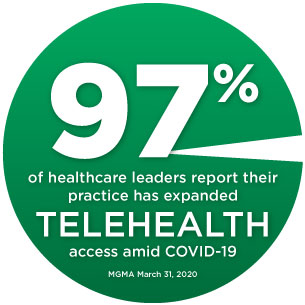COVID-19 Ignites Telehealth Services
posted
on Friday, April 17, 2020
 In the blink of an eye the healthcare world exploded. The quick rise of COVID-19 has practices scrambling to find ways to treat patients in the safest environments possible. All the while, the one constant that remains is the commitment from practices around the country to communicate and keep their patients healthy and well.
In the blink of an eye the healthcare world exploded. The quick rise of COVID-19 has practices scrambling to find ways to treat patients in the safest environments possible. All the while, the one constant that remains is the commitment from practices around the country to communicate and keep their patients healthy and well.
Patient communication is the glue needed to help patients and providers navigate these times.
Practices need to communicate:
- Preventive measures and protocols for in-office visits
- What patients should do if they have COVID-19 symptoms
- Temporary practice closings and more
- And perhaps one of the most pressing needs of all – virtual care options for patients
Roger Severino, Director of the Office of Civil Rights (OCR) in the Department of Health and Human Services (DHHS), said “We are empowering medical providers to serve patients wherever they are during this national public health emergency.”
Effective March 6, 2020 and for the duration of the COVID-19 Public Health Emergency, the Center for Medicare and Medicaid Services announced it would allow all qualified healthcare providers to care for patients remotely without meeting existing Medicare and Medicaid requirements, established prior to COVID-19. Practices are also able to offer this type of care with some restrictions being lifted regarding HIPAA and related penalties. Insurance companies announced they would immediately expand coverage for telehealth services to help patients engage with their provider virtually from the comfort of their own home.
Practices again found themselves scrambling to not only ignite but communicate these telehealth services to their patients. According to the MGMA, 97 percent of healthcare leaders report their practice has expanded telehealth access amid COVID-19. They have done so by using video conferencing services and devices like Smart Phones, Zoom, Skype, Facetime, Whatsapp, patient portals and third party platforms. Practices find themselves having to not only promote these services, but also educate patients on how and when to use these services.
As the days, weeks and months unfold, telehealth will continue to evolve and morph into a more vibrant and systemized offering for patients. Communication is the key to patient utilization and long-term adoption of telehealth.
Practices need to communicate to patients. And many are choosing to do this through patient mailings, texts, phone calls, emails, Web updates and portal announcements.
For more than 50 years, POS Professional Office Services has helped practices communicate important practice and patient news. Even during this difficult time, POS is helping practices elevate telehealth and will continue to consult and share ideas from healthcare groups around the country.
We know the one thing that won’t change in healthcare is the need for strong communication channels and engagement between providers and patients. This has never been truer than during these COVID-19 days – a time that will mark the launch of consumer-centric care in a digital world.